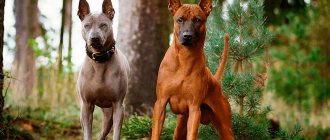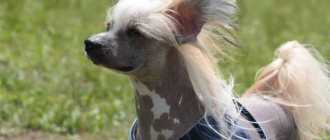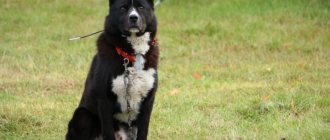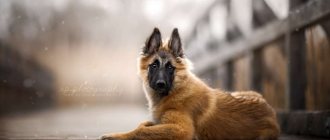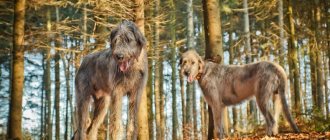If you need not only a loyal friend, but also an excellent protector, then the German Boxer dog breed is what you need. From the photo of the German boxer it is clear that this breed of dog was simply created to protect humans.
In many cases, this type of dog is used for police service and private security. However, despite its muscular body and intimidating appearance, this breed has a kind character. This means that such a dog is capable of becoming a loyal friend and comrade for its owner.
Breed traits
Breed traits (on a 5-point scale)
| German boxer | |||
| Activity | in the house | 3.1 | |
| on the street | 4.3 | ||
| Obedience | training | 3.6 | |
| strangers | 3.9 | ||
| Domination | in family | 2 | |
| over dogs | 3 | ||
| Defending your territory | from people | 2.5 | |
| from dogs | 3.3 | ||
| Sociability | in family | 4.9 | |
| with strangers | 3.6 | ||
| with dogs | 3.5 | ||
| Concentration | in family | 1.1 | |
| in front of strangers | 2 | ||
| with dogs | 1.8 | ||
| Aggressiveness | in family | 1.1 | |
| to strangers | 2 | ||
| to the dogs | 2.4 | ||
| to cats | 2.7 | ||
| Family behavior | calmness | 4 | |
| demand for affection | 4.4 | ||
| excitability | 3.8 | ||
| playfulness | 4.6 | ||
| excessive barking | 1.9 | ||
| behavioral breakdowns | 2.2 | ||
| Tolerance for children | up to 4 years | 4.5 | |
| over 4 years old | 4.6 | ||
| Institutional use | watchman | 4.2 | |
| bodyguard | 2.9 | ||
This breed is often compared to the following dog breeds: American Staffordshire Terrier, Cane Corso, Doberman Pinscher, German Shepherd, English Bulldog.
Photos of representatives of the Boxer breed show what they look like:
German boxer dog
Boxer breed
German boxer breed
Nutrition
You should take moderation in your diet and not overdo it with treats, although the Boxer knows how to ask for goodies. From 2 months to six months you should feed 4 times a day. From 6 months to 10 months - 3 times a day, after which switch to a twice-a-day diet.
German boxer mother with puppy
A healthy diet for a German Boxer should include a variety of healthy foods: meat, fish, cereals, grains, dairy products, vegetables and fruits. It is allowed to treat your dog with treats from veterinary stores. Fatty meats, flour and sweets are completely contraindicated.
General characteristics of the Boxer breed
German Boxers are medium-sized dogs. They are stocky, strong, and have a characteristic menacing expression on their wide muzzle with an upturned nose. The appearance of this dog is quite recognizable. And by nature he is flexible, cheerful and loyal. Boxers are affectionate with their family members, love children, and get along with other pets. But they are distrustful of strangers, and they can enter into conflicts with other people’s dogs.
When breeding the breed, the breeders pursued the goal of obtaining a non-aggressive, manageable dog. Therefore, boxers have a genetically inherent desire to serve people. This is the best security guard, bodyguard and watchman.
These dogs have a balanced character and a stable nervous system; they serve in the police and search and rescue teams. And thanks to their sensitivity and desire to protect the weak, they are often used as guides for the blind and disabled. Now the breed is increasingly considered to be the best companion, family dog.
Photos complement the description of German boxers:
| options | characteristic |
| breed name | Boxer (boxer) or German boxer |
| country of origin | Germany |
| time of birth of the breed | 1850 |
| group of breeds according to the ICF classification | Pinschers and Schnauzers, Molossians |
| usage | bodyguard, watchman, guide dog, detection dog, companion |
| peculiarities | active temperament, stable psyche, flexible character |
| life expectancy | 11-12 years old |
| height | male 57-63 cm, female 53-59 cm |
| weight | male 28-33 kg, female 25-28 kg |
| aggressiveness | average, with proper upbringing is a calm and friendly dog |
| activity | tall, needs long walks and physical activity |
| attitude towards people | sociable, good-natured and affectionate with members of the owner’s family, wary of strangers |
| training | easy to train, intelligent and understanding, but can be stubborn |
| care | easy, doesn't shed much |
pros
The main advantage of these dogs is that they are easy to train and are suitable even for inexperienced dog owners. Boxers are one of the most popular dog breeds. They have many advantages:
- good guard qualities;
- suitable for keeping in an apartment;
- unpretentious, do not require complex care;
- cheerful, playful and sociable;
- balanced, flexible character;
- easy to train, not prone to dominance;
- treat children well;
- very devoted, faithful;
- fearless, will selflessly protect a person.
Minuses
Boxers are sometimes ranked among the most dangerous breeds. Despite the fact that they were not bred as fighting dogs, many consider them to be angry and aggressive. The reason is their intimidating appearance and the fact that they are often confused with bulldogs or pit bulls. Although in fact, a boxer can attack a person only if he is brought up incorrectly, if he is specifically developed to develop aggression in him.
But representatives of the breed also have disadvantages. Before getting such a dog, you need to understand that it:
- very active, mobile, needs high physical activity;
- does not tolerate cold, is not suitable for keeping in the yard, often catches colds;
- prone to overeating and weight gain;
- cunning and stubborn;
- can be noisy and intrusive;
- unclean, likes to roll around in the dirt, prone to drooling;
- snores, often suffers from flatulence;
- does not tolerate loneliness well, when bored, it can turn everything in the house upside down;
- has poor health, low life expectancy;
- often gets into fights with other dogs.
The video will complement the characteristics of boxers, their pros and cons:
Video: Boxer dog pros and cons of the breed
Interesting facts about the German Boxer breed
German boxers are a unique breed. It has several interesting features.
- The breed was named this way because these dogs behave interestingly when they fight. They use their forelimbs, swinging them as if they were boxing.
- Representatives of this breed have a universal blood type. Therefore, veterinarians often use them as donors.
- This is one of the few breeds whose representatives do not like water and cannot swim.
- These dogs mature late. At one and a half years old, he is still a puppy, mischievous and naughty. Therefore, it seems that training a boxer is difficult, although refusal to follow commands at this age is associated with emotional immaturity.
History of the origin of the German Boxer dog breed
The ancestors of boxers were Bullenbeisers, English bulldogs, and mastiffs. These are ancient breeds that were used for baiting, hunting, bullfighting, and military purposes. You can find images of dogs similar to modern boxers dating back to the 17th century. But they appeared as a separate breed in the middle of the 19th century. From bullenbeisers and bulldogs they got the characteristic shape of the muzzle, from mastiffs they got a stocky build, strength and endurance. Some dog experts believe that Tibetan Great Danes and German Shepherds also participated in breeding.
Breeders in Germany tried to breed a dog with guarding and service qualities, but not aggressive and obedient. Although the first representatives of the breed were sometimes still used as fighting dogs or for hunting wild animals.
But by the end of the 19th century, boxers began to be valued as service dogs. They helped shepherds, guarded houses, and transported goods. During the war they worked as scouts, orderlies and postmen. The ability of these dogs to perform tricks was discovered, and they began to be used in the circus. Due to the unique habit of moving its front paws in the air, the breed was called the German Boxer.
In the 90s of the 19th century, clubs for fans of the breed began to be created, and it spread throughout the world. It is still especially popular in America. Some experts even distinguish a type of breed - American Boxers. Dog breeders love the impressive appearance of these dogs, as well as their easy-going nature and good nature.
The first breed standard was created at the beginning of the 20th century. According to him, boxers were stocky, strong and powerful. The ears and tail should be docked, and there should be a groove on the nose dividing the muzzle in half. These appearance features are associated with fighting ancestors. Since 2002, the standard has prohibited ear and tail docking, and the dog's physique has become more graceful.
Old photographs show how modern boxers differ from their ancestors:
Old photo of a German boxer
Old photo of a boxer dog
Varieties
There are several sub-breed groups of boxers.
German
These dogs are the only ones recognized by the International Canine Federation. The breed is universal and exhibits excellent guarding qualities. The character of Boxers is balanced, they are incredibly loyal to their owner. Aggression is not typical of German dogs.
American
This breed doesn't actually exist. After the end of World War II, the German boxer gained enormous popularity not only in European countries, but also in America. The Americans took several puppies to their homeland, and it was they who became the founders of a new breed group. Such dogs have a lighter build and a smaller head, but only experienced dog handlers can notice such differences.
Brindle
Most popular among dogs with brindle coloration. The suit is characterized by the presence of stripes of dark color, which are located along the main color. The coat of such dogs should be short, shiny and close to the body. Thanks to this coloring, the muscles on the pet’s body appear more prominently.
Features of the appearance of representatives of the Boxer breed
The German Boxer is a medium-sized dog with a stocky build and almost square build. The bones are strong, the muscles are developed, prominent, but dry. Therefore, the dog looks lean and athletic. According to the standard, the average height of a German boxer is 60 cm for males and 55 cm for females. With this size, the dog weighs only 25-30 kg.
Characteristic appearance features:
- muscular, harmoniously built body;
- square head;
- protruding lower jaw;
- upturned nose;
- small folds of skin on the cheeks, pronounced jowls;
- smart, inquisitive look;
- short hair.
The pictures show what a German boxer should look like:
Head of a German boxer
This is what a German boxer looks like
Dogs of the German Boxer breed
Head
The head is proportional to the body and does not look too massive. The skull is moderately convex, may be angular, with a groove between the eyes. The occipital protuberance is poorly defined. The transition from forehead to nose is distinct. The muzzle is wide and voluminous. The bridge of the nose is straight, not curved upward, like in bulldogs. But the tip of the nose is slightly turned up. The lobe is wide, black.
The lower jaw is longer than the upper, slightly curved upward, and the chin is pronounced. The teeth are strong, large, and should not be visible from behind the lips. This breed is characterized by overeating. Lips are black. The upper one is fleshy and large. It covers the jaw, but does not hang low.
Eyes are medium size, dark. The look is friendly and attentive. The ears are small and triangular. Set high, hanging down and close to the cheekbones. If the ears are cropped, they are small, triangular, and erect.
The photo shows the features of the muzzle:
Muzzle of a German boxer
Boxer muzzle
Feature of the muzzle of a German boxer
Body type
The neck is powerful, muscular, and of medium length. From the occipital protuberance to the withers it forms a small arc. The physique is harmonious, the dog does not look too powerful or graceful. The withers are well defined, the back is straight and wide. The croup is rounded and sloping. The chest is wide, deep, reaching to the elbows. The stomach is tucked. The tail is set high, medium length, thin. Since 2002 it has not stopped.
Limbs
The limbs are smooth and muscular. The front ones are placed parallel. The shoulders are long, the elbows are not tightly pressed to the chest. The hind legs are slightly longer than the front ones and are muscular. The thighs are long, the hocks are pronounced. The paws are round and compact. Movements are energetic and free.
Photos complement the description of the appearance of representatives of the Boxer breed:
Appearance of a German boxer
German boxers, appearance
Coat and colors of German boxers
The skin is dry, without wrinkles. Sometimes they form on the forehead when the dog is excited. The coat is smooth and shiny. The hair is short, close to the skin, and hard. The breed standard allows only two colors of boxers: red and brindle. The first variety can have any shades - from yellow to red-brown. Bright red color is preferred.
The brindle German boxer has black stripes on a red background. They are contrasting, clearly defined, located along the ribs. Dogs of any color are characterized by a black mask on the face. White spots are allowed on the chest, paws, muzzle, and belly. They should not occupy more than 30% of the body surface.
Pure white German Boxers are now rare. Although this was previously the main color of the breed, now it is not provided for by the standard. Dogs of any color other than red or brindle, or if there are many white spots on the coat, are not allowed to participate in exhibitions.
Photos of boxers of different colors:
Brindle German Boxer
Red German Boxer
German boxer red color
White German boxer, not included in the standard
Character of the Boxer breed
The German Boxer is a loyal, balanced and affectionate pet. This is a service breed, intended for protection and protection. She is hardy, calm, and distrustful of strangers. The dog is smart, fearless and self-confident. But among other guard dogs, the boxer is distinguished by its cheerfulness and playfulness. He is cheerful, loves to fool around and play pranks.
With members of his family, he is an affectionate and cheerful companion. He becomes very attached to his owner, loves to spend time with him and take part in all activities. Treats all familiar people kindly. He behaves reservedly and warily with strangers. He never loses his vigilance and is ready to defend himself in a dangerous situation.
This dog is suitable for active people who can devote 2-3 hours daily to walks. You need to run and play with this dog, he loves to chase the ball. He gets along well with other pets who live in the same house with him. But on the street he may chase a bird or a cat. He often gets into fights with dogs.
Boxers love children and enjoy spending time with them. This dog is ready to support any game and will never offend a child. For a teenager he will become a loyal friend and bodyguard. He treats small children with care and protects them.
These dogs have the following qualities:
- cheerful;
- sociable;
- noisy;
- inquisitive;
- smart;
- understanding;
- faithful;
- good-natured;
- balanced;
- patient;
- energetic;
- playful;
- hardy;
- stubborn;
- fearless.
The pictures show the character traits of these pets:
German boxer running through mud
German boxer playing ball
German boxer with a child
Features of education and training of boxers
The German Boxer is easy to train. He trains well, is able to master the course of protective guard duty, and learn various tricks. These dogs are used for police work, as bodyguards, and guide dogs. After all, they are balanced, understanding, and love to help people. You just need to take into account that representatives of this breed, up to 2-3 years old, behave like puppies: they fool around and show disobedience. But this does not prevent them from subsequently becoming excellent guards and watchmen.
Another feature of raising a boxer is that this dog remembers commands better during the game. He needs to be interested, use encouragement and praise. They react poorly to punishment or rudeness and may become uncontrollable. Sometimes these dogs can be stubborn, so you need to find the right approach to your pet, then he will easily learn all the commands. The basic rules of successful training are consistency, firmness, regularity.
You need to educate a German from the first days of his appearance in the house. The puppy must immediately learn the rules of behavior and become familiar with the prohibitions. The most important commands that a pet must obey unquestioningly:
- to me;
- sit;
- place;
- it is forbidden;
- ugh;
- stand;
- near.
Early socialization is also important for these dogs. If you do not accustom your boxer to street noise, strangers, dogs and birds, he will lunge at everyone and bark. At home, you need to immediately stop chewing things, begging for food, and jumping on the bed. Improperly raised pets often grow up to be inadequate and can create problems.
The video shows how to raise these dogs:
Video: How to properly train a German boxer!
Video: German boxer. It guards your mood, not your property.
Video: Meet boxer Boni.
Key points in training
You need to start training a dog from a very early age, preferably from the first after it appears in the house. It is important to accustom your pet to its name, toilet, feeding and sleeping place. After this, you can start learning the basic commands:
- "Near";
- "Place";
- "It is forbidden";
- "Drop";
- "Sit",
- "Lie";
- "Serve";
- "Voice".
Boxers are incredibly intelligent and quick to learn, but tend to be stubborn. Therefore, as an adult, it is difficult to get him interested in activities. Puppies are often distracted. All training should be carried out in a playful manner, without the use of brute force and with motivation (treats, toys).
German Boxers are prone to dominance, so they need a strict owner who can show his leadership qualities and convince the pet to obey.
Read about how to properly train a dog in the article: “Training a puppy: effective methods from dog handlers, learning commands at home.”
Maintenance and care
The German Boxer is a hardy watchdog. He loves to walk in the fresh air; at least one walk a day should be long and active. But it is not suitable for keeping outside, especially in cold weather. Due to their short coat and lack of undercoat, these dogs get cold quickly. They catch colds and suffer from rheumatism. Therefore, when walking in winter and during rain, your pet needs to wear clothes. It is recommended to let him off leash only at a dog park or outside the city.
But this dog also doesn’t tolerate heat well. He may overheat and get sunstroke. In the house you need to choose a place for your pet away from drafts and heating devices. The bed should be spacious. It is not recommended to allow Boxers to sleep on sofas, as they are prone to drooling and can stain furniture.
Interesting photos illustrate the features of keeping these dogs:
Hygiene procedures
These pets are unpretentious and easy to care for. Normal hygiene procedures are required.
- The coat is short and smooth, so brushing once a week is sufficient. To do this, use a brush with stiff bristles or a rubber mitt. The procedure helps remove dead hair. To make the wool shiny, you can rub it with a piece of leather dipped in water.
- You should bathe with shampoo no more than 3-4 times a year. After a walk, it is enough to wash your paws with warm water and wipe the dirty areas of the body with a damp cloth.
- If the dog doesn't walk on the pavement a lot, the nails won't wear down. When they grow back, they cause pain to the animal and interfere with walking. Nails need to be trimmed regularly.
- Due to droopy eyelids, boxers are prone to eye inflammation. Therefore, you need to inspect and wipe them every day. If necessary, use veterinary lotions or drops.
- Wipe your ears once a week. It is not recommended to use cotton swabs, a napkin is better.
- Boxers are prone to excessive salivation. You need to regularly wipe your pet's face with a towel.
The video will help you understand how to care for your pet:
Video: Boxer Dog. Dog care: cleaning ears, cutting nails.
Video: Is it difficult to keep a German Boxer?
Nutrition
A boxer's nutrition needs to be given special attention. These animals are prone to diseases of the digestive tract, allergies, and accumulation of excess weight. They need to be fed at the same time, after 10 months, twice a day. The portion should be no more than 20% of the animal’s body weight. You should not overfeed your pet; often give treats and food from your table.
Representatives of this breed are best fed with natural products. The main part of the diet is lean meat. You should also give eggs, sea fish, fermented milk products, and cereals. Useful vegetables include carrots and pumpkin. Additionally, add multivitamin complexes to your food, calcium is especially important.
If the owner decides to feed the pet prepared food, you need to choose high-quality super-premium or holistic dry food. They are enriched with essential microelements and do not contain dyes or artificial components that can cause allergies. Suitable foods include Orijen, Acana, Applaws, Grandorf, Farmina Natural & Delicious, Belcando, Pronature Holistic.
Health
These pets have poor health; rarely does a German boxer live longer than 10 years. They have poor immunity and are also prone to the following diseases:
- entropion, conjunctivitis and other eye diseases;
- heart pathologies;
- rheumatism;
- hypothyroidism;
- allergy;
- breathing problems;
- colds;
- arthritis, joint dysplasia;
- volvulus, flatulence;
- obesity;
- oncological diseases;
- congenital deafness.
Boxer diseases
Despite their powerful muscular body, endurance and strength, boxers, like other dogs, are susceptible to various diseases.
The most common diseases are:
- Pathologies of the cardiac and vascular systems: aortic valve stenosis and cardiomyopathy;
- Volvulus (tympanitis);
- Oncological diseases;
- Colitis (inflammatory process of the colon);
- Thyroid disease (hypothyroidism);
- Hip dysplasia (hereditary disease);
- Corneal dystrophy (eye disease);
It should be remembered that in order to prevent the disease and begin treatment on time, you need to systematically conduct examinations with a veterinarian. Today there are many modern diagnostics that allow early detection of deviations from the norm and various pathologies.
How to buy a German Boxer puppy
It is best to buy a puppy from a good nursery. Although its cost is higher than when buying it secondhand. But you can avoid the fact that the dog will be a mixed breed or have hereditary diseases. The price of a thoroughbred boxer in Moscow is 15-30 thousand rubles. Puppies with good pedigree from champion parents will cost 40-60 thousand rubles. If a breeder offers a dog for less than 10 thousand rubles, it either does not have a pedigree or is sick. It is recommended to buy an animal with vaccinations; it must have a veterinary passport.
When choosing a puppy, you need to not only study the documents and conditions of detention. It is important to carefully examine the baby himself. Puppies for sale at the age of 2-3 months. By this time, they already show breed characteristics: strong build, square muzzle, undershot, large paws. The color is red or brindle, the coat is shiny, without bald spots. The puppy must be active, not cowardly or aggressive. A healthy baby is curious, playful, and easy to communicate with.
The photo shows what the puppies should look like:
Look at some more interesting photos and pictures from the Internet that complement the description of these dogs:
Interesting videos will help you decide whether to get a Boxer:
Video: Boxer all about the breed. Interesting Facts
Video: Boxer - All about the dog breed
Video: The dog of the intelligentsia is a boxer
German boxers are dogs that only look menacing in appearance. In fact, they are affectionate and loyal, cheerful and good-natured. They need constant attention, get very bored in the absence of their owner and cannot tolerate a sedentary lifestyle. Therefore, this breed is not suitable for everyone. It is recommended for families with children and active young people to have one. If this dog is properly raised and loved, it will become a devoted friend, a brave protector and a cheerful companion.
Vaccinations
their first vaccination at 8 weeks of age. Then after 4 weeks a second vaccination is given. This is done in order to create stable specific immunity in the pet.
During repeated vaccination, a complex vaccine is administered that contains the rabies virus.
Immunobiological drugs are then administered upon reaching one year of age and repeated every 12 months.
Vaccination provides your pet with lasting immunity to the following diseases:
- plague;
- rabies;
- parainfluenza;
- hepatitis;
- enteritis;
- leptospirosis.
Important! Two weeks before vaccination, the dog must be treated for worms and parasites.
Timely vaccinations will help to avoid many health problems in Boxers and will contribute to longevity.


